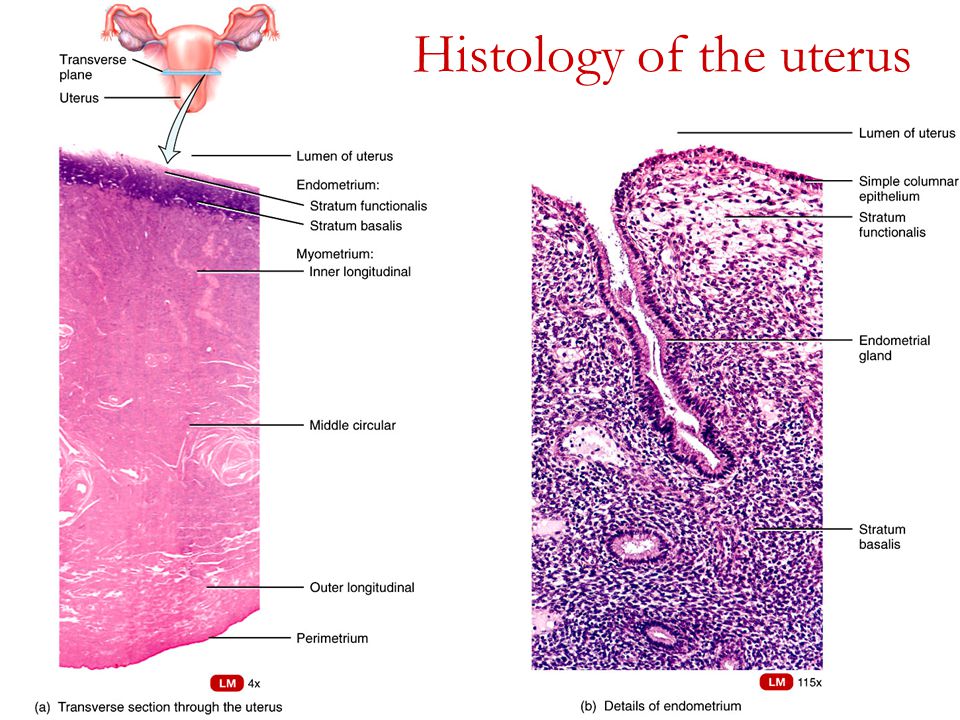Inflammation within the uterus. Endometritis: Causes, Symptoms, and Treatment of Uterine Inflammation
What is endometritis. How does it differ from endometriosis. What are the main causes and risk factors for developing endometritis. What symptoms should you watch out for. How is endometritis diagnosed and treated. What complications can arise if left untreated. How does endometritis impact fertility.
Understanding Endometritis: An Overview of Uterine Inflammation
Endometritis is a condition characterized by inflammation of the endometrium, the inner lining of the uterus. This inflammatory condition can lead to various symptoms and complications if left untreated. Unlike endometriosis, where endometrial-like tissue grows outside the uterus, endometritis is confined to the uterine lining itself.
The condition can be acute or chronic, with acute cases often developing after childbirth, miscarriage, or certain medical procedures. Chronic endometritis, on the other hand, may persist for an extended period and can be associated with various underlying causes.

Differentiating Endometritis from Related Conditions
It’s crucial to distinguish endometritis from other conditions affecting the uterus:
- Endometriosis: A condition where endometrial-like tissue grows outside the uterus
- Endomyometritis: Inflammation that extends to the myometrium (middle layer of the uterus)
- Adenomyosis: A condition where endometrial tissue grows into the muscular wall of the uterus
Understanding these distinctions is essential for proper diagnosis and treatment.
Common Causes and Risk Factors for Endometritis
Endometritis typically results from bacterial infections that ascend from the vagina or cervix into the uterus. Several factors can increase the risk of developing this condition:
Bacterial Infections
Various bacteria can cause endometritis, including:
- Chlamydia trachomatis
- Neisseria gonorrhoeae
- Mycoplasma genitalium
- Group A Streptococcus
- Staphylococcus aureus
Obstetric and Gynecological Procedures
Certain medical procedures can increase the risk of endometritis:

- Cesarean section (C-section)
- Prolonged labor
- Dilation and curettage (D&C)
- Hysteroscopy
- Endometrial biopsy
- Intrauterine device (IUD) insertion
Other Risk Factors
Additional factors that may contribute to the development of endometritis include:
- Sexually transmitted infections (STIs)
- Bacterial vaginosis
- Retained products of conception after childbirth or miscarriage
- Immunosuppression
- Pelvic inflammatory disease (PID)
Recognizing the Symptoms of Endometritis
The symptoms of endometritis can vary in severity and may not always be present. However, recognizing potential signs is crucial for early detection and treatment.
Common Symptoms
Individuals with endometritis may experience:
- Lower abdominal or pelvic pain
- Abnormal vaginal bleeding or discharge
- Fever and chills
- Uterine tenderness
- General discomfort or malaise
- Painful urination
Postpartum Endometritis Symptoms
In cases of postpartum endometritis, additional symptoms may include:
- Foul-smelling lochia (postpartum vaginal discharge)
- Uterine subinvolution (delayed return to normal size)
- Tachycardia (rapid heart rate)
Is endometritis always symptomatic? No, in some cases, particularly in chronic endometritis, symptoms may be subtle or absent, making diagnosis challenging.

Diagnosing Endometritis: Medical Evaluation and Tests
Accurate diagnosis of endometritis is crucial for appropriate treatment. Healthcare providers employ various methods to confirm the condition:
Physical Examination
A thorough pelvic examination may reveal:
- Uterine tenderness
- Cervical motion tenderness
- Abnormal vaginal discharge
Laboratory Tests
Several tests can help diagnose endometritis:
- Complete blood count (CBC) to check for elevated white blood cell count
- C-reactive protein (CRP) levels to assess inflammation
- Erythrocyte sedimentation rate (ESR) to measure inflammation
- Vaginal and cervical cultures to identify causative organisms
- Endometrial biopsy to examine uterine tissue
Imaging Studies
In some cases, imaging techniques may be employed:
- Transvaginal ultrasound to evaluate uterine thickness and detect fluid accumulation
- Hysteroscopy to visualize the uterine cavity
- MRI or CT scan in complex cases or to rule out other conditions
Can endometritis be diagnosed solely based on symptoms? While symptoms can provide important clues, a definitive diagnosis typically requires a combination of clinical evaluation, laboratory tests, and sometimes imaging studies.

Treatment Approaches for Endometritis
The primary goal of endometritis treatment is to eliminate the underlying infection and alleviate symptoms. The approach may vary depending on the severity and cause of the condition.
Antibiotic Therapy
Antibiotics are the cornerstone of endometritis treatment:
- Broad-spectrum antibiotics are often prescribed initially
- Treatment may be adjusted based on culture results
- Common antibiotics include doxycycline, metronidazole, and clindamycin
- Intravenous antibiotics may be necessary for severe cases
Supportive Care
Additional measures to manage symptoms and support recovery include:
- Pain management with over-the-counter or prescription analgesics
- Fluid replacement in cases of dehydration
- Rest and limited physical activity during recovery
Treatment of Underlying Conditions
Addressing any contributing factors is essential:
- Treatment of sexually transmitted infections
- Removal of retained products of conception if present
- Management of other pelvic inflammatory conditions
How long does it take to recover from endometritis? With appropriate antibiotic treatment, most cases of acute endometritis resolve within 2-3 weeks. However, chronic cases may require longer treatment and follow-up care.

Potential Complications and Long-term Effects of Endometritis
If left untreated or inadequately managed, endometritis can lead to various complications:
Acute Complications
- Sepsis: A life-threatening condition resulting from widespread infection
- Pelvic abscess formation
- Peritonitis: Inflammation of the abdominal lining
Chronic Complications
- Infertility or reduced fertility
- Increased risk of ectopic pregnancy
- Chronic pelvic pain
- Recurrent pelvic infections
Impact on Pregnancy
Endometritis can affect future pregnancies in several ways:
- Increased risk of preterm labor and delivery
- Higher likelihood of placental abnormalities
- Potential for intrauterine growth restriction
Can endometritis cause permanent damage to the uterus? In most cases, with prompt and appropriate treatment, endometritis does not cause permanent uterine damage. However, severe or recurrent cases may lead to scarring or adhesions that can impact fertility or future pregnancies.
Endometritis and Fertility: Understanding the Connection
The relationship between endometritis and fertility is an important consideration for individuals planning to conceive.

Impact on Conception
Endometritis can affect fertility in several ways:
- Altering the uterine environment, making it less favorable for implantation
- Causing inflammation that may interfere with sperm transport or embryo development
- Leading to scarring or adhesions that can obstruct fallopian tubes
Chronic Endometritis and Recurrent Pregnancy Loss
Research has suggested a link between chronic endometritis and recurrent pregnancy loss:
- Some studies indicate higher rates of chronic endometritis in women with recurrent miscarriages
- Treatment of chronic endometritis may improve pregnancy outcomes in affected individuals
Fertility Treatment Considerations
For those undergoing fertility treatments:
- Screening for and treating endometritis may be recommended before assisted reproductive techniques
- Addressing underlying endometritis could potentially improve IVF success rates
Does endometritis always lead to infertility? No, endometritis does not always cause infertility. Many cases, when promptly and effectively treated, do not result in long-term fertility issues. However, severe or chronic cases may increase the risk of fertility problems.

Preventing Endometritis: Strategies for Reducing Risk
While not all cases of endometritis can be prevented, certain measures can help reduce the risk of developing this condition:
Sexual Health Practices
- Practice safe sex to reduce the risk of sexually transmitted infections
- Get regular STI screenings if sexually active
- Treat any diagnosed STIs promptly and ensure partners are also treated
Obstetric and Gynecological Care
- Follow proper hygiene practices during childbirth and postpartum period
- Adhere to recommended guidelines for cesarean section procedures
- Use prophylactic antibiotics as advised for certain gynecological procedures
General Health Measures
- Maintain good overall health and a strong immune system
- Practice good hygiene, especially during menstruation
- Seek prompt medical attention for any signs of pelvic infection or unusual vaginal symptoms
Can endometritis be completely prevented? While it’s not possible to prevent all cases of endometritis, following these preventive measures can significantly reduce the risk of developing the condition.

Understanding endometritis, its causes, symptoms, and potential complications is crucial for early detection and effective management. By recognizing the signs, seeking prompt medical attention, and following appropriate treatment plans, individuals can minimize the impact of this condition on their health and fertility. Regular check-ups, maintaining good sexual health practices, and adhering to recommended obstetric and gynecological care guidelines are key steps in reducing the risk of endometritis and ensuring overall reproductive health.
Endometritis: MedlinePlus Medical Encyclopedia
URL of this page: //medlineplus.gov/ency/article/001484.htm
To use the sharing features on this page, please enable JavaScript.
Endometritis is an inflammation or irritation of the lining of the uterus (the endometrium). It is not the same as endometriosis.
Endometritis is caused by an infection in the uterus. It can be due to chlamydia, gonorrhea, tuberculosis, or a mix of normal vaginal bacteria. It is more likely to occur after miscarriage or childbirth. It is also more common after a long labor or C-section.
The risk for endometritis is higher after having a pelvic procedure that is done through the cervix. Such procedures include:
- D and C (dilation and curettage)
- Endometrial biopsy
- Hysteroscopy
- Placement of an intrauterine device (IUD)
- Childbirth (more common after C-section than vaginal birth)
Endometritis can occur at the same time as other pelvic infections.
Symptoms may include:
- Swelling of the abdomen
- Abnormal vaginal bleeding or discharge
- Discomfort with bowel movement (including constipation)
- Fever
- General discomfort, uneasiness, or ill feeling
- Pain in lower abdomen or pelvic region (uterine pain)
The health care provider will perform a physical exam with a pelvic exam. Your uterus and cervix may be tender and the provider may not hear bowel sounds. You may have cervical discharge.
The following tests may be performed:
- Cultures from the cervix for chlamydia, gonorrhea, and other organisms
- Endometrial biopsy
- ESR (erythrocyte sedimentation rate)
- Laparoscopy
- WBC (white blood count)
- Wet prep (microscopic exam of any discharge)
You will need to take antibiotics to treat the infection and prevent complications. Finish all your medicine if you have been given antibiotics after a pelvic procedure. Also, go to all follow-up visits with your provider.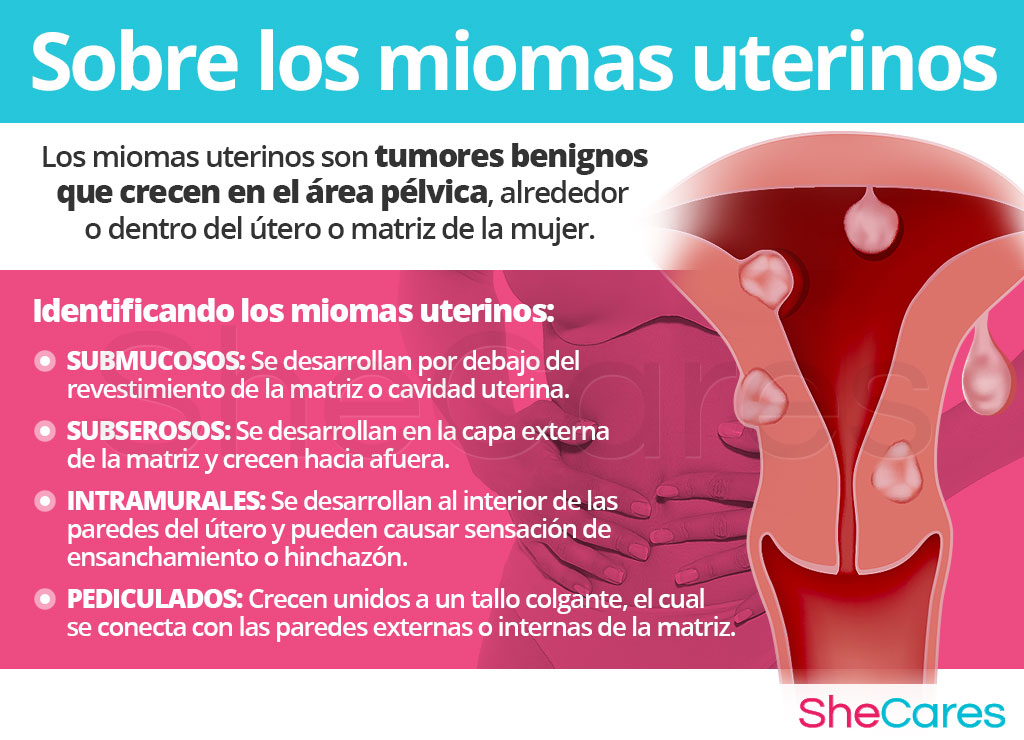
You may need to be treated in the hospital if your symptoms are severe or occur after childbirth.
Other treatments may involve:
- Fluids through a vein (by IV)
- Rest
Sexual partners may need to be treated if the condition is caused by a sexually transmitted infection (STI).
In most cases, the condition goes away with antibiotics. Untreated endometritis can lead to more serious infections and complications. Rarely, it may be associated with a diagnosis of endometrial cancer.
Complications may include:
- Infertility
- Pelvic peritonitis (generalized pelvic infection)
- Pelvic or uterine abscess formation
- Septicemia
- Septic shock
Call your provider if you have symptoms of endometritis.
Call right away if symptoms occur after:
- Childbirth
- Miscarriage
- Abortion
- IUD placement
- Surgery involving the uterus
Endometritis may be caused by STIs.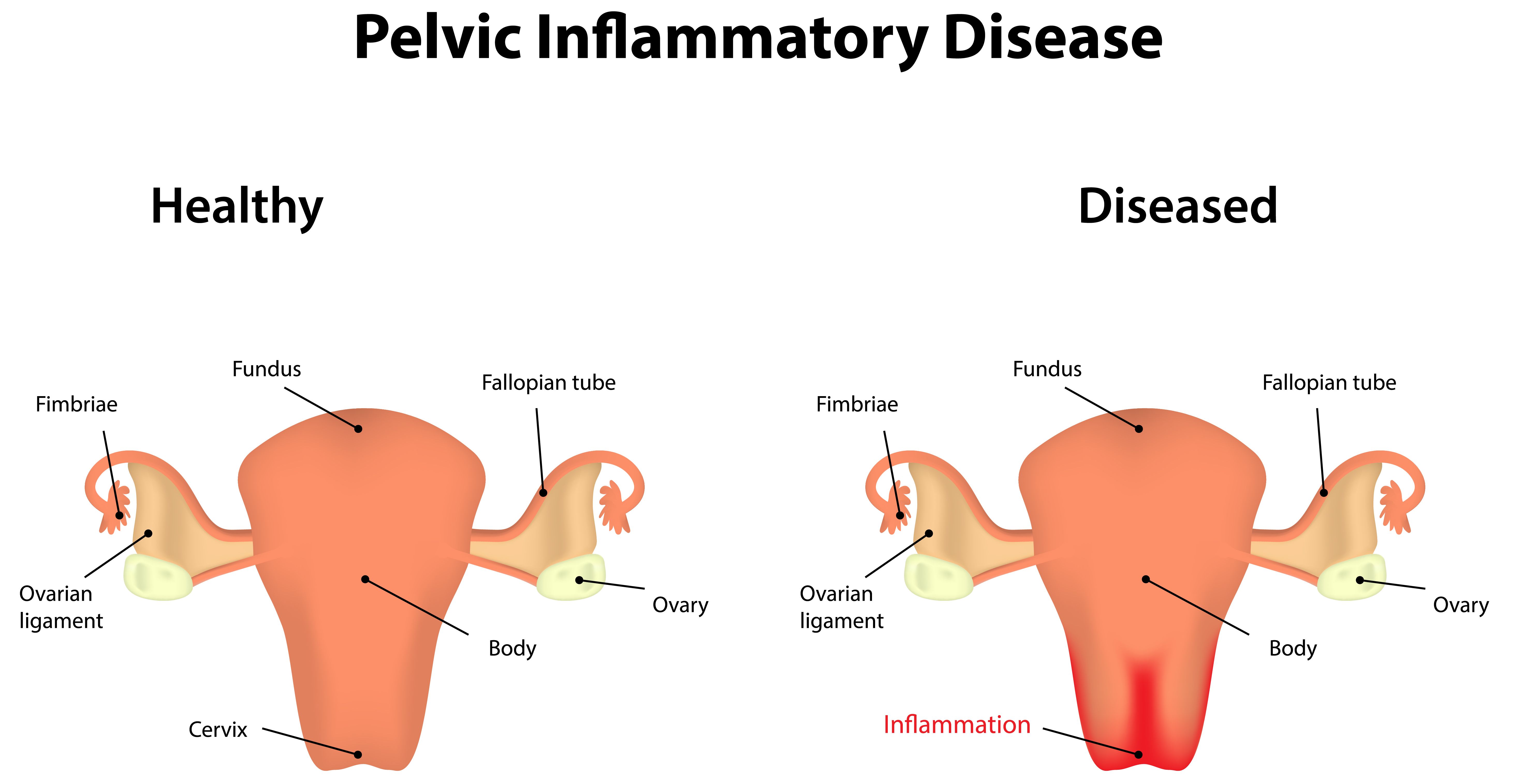 To help prevent endometritis from STIs:
To help prevent endometritis from STIs:
- Treat STIs early.
- Make sure sexual partners are treated in the case of a STI.
- Follow safer sex practices, such as using condoms.
Women having a C-section may have antibiotics before the procedure to prevent infections.
- Pelvic laparoscopy
- Endometritis
Centers for Disease Control and Prevention website. Sexually transmitted infections treatment guidelines, 2021. www.cdc.gov/std/treatment-guidelines/default.htm. Updated July 22, 2021. Accessed August 31, 2021.
Duff WP. Maternal and perinatal infection in pregnancy: bacterial. In: Landon MB, Galan HL, Jauniaux ERM, et al, eds. Gabbe’s Obstetrics: Normal and Problem Pregnancies. 8th ed. Philadelphia, PA: Elsevier; 2021:chap 58.
Eckert LO, Lentz GM. Genital tract infections: vulva, vagina, cervix, toxic shock syndrome, endometritis, and salpingitis. In: Gershenson DM, Lentz GM, Valea FA, Lobo RA, eds.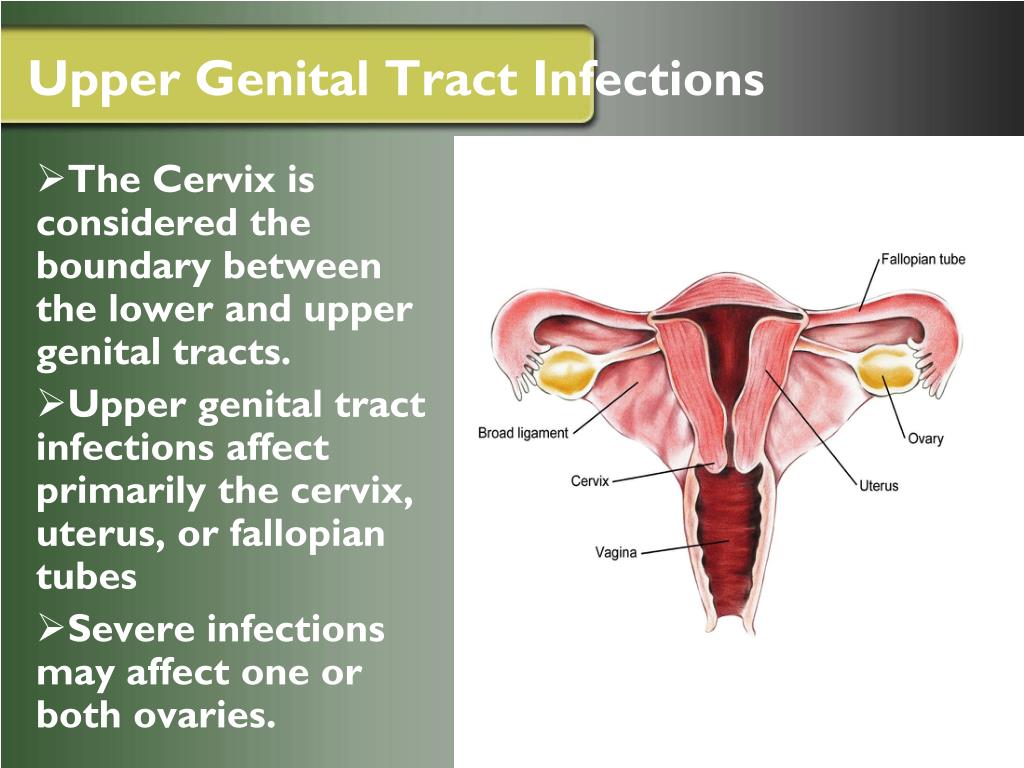 Comprehensive Gynecology. 8th ed. Philadelphia, PA: Elsevier; 2022:chap 23.
Comprehensive Gynecology. 8th ed. Philadelphia, PA: Elsevier; 2022:chap 23.
Updated by: John D. Jacobson, MD, Department of Obstetrics and Gynecology, Loma Linda University School of Medicine, Loma Linda, CA. Also reviewed by David Zieve, MD, MHA, Medical Director, Brenda Conaway, Editorial Director, and the A.D.A.M. Editorial team.
Endometritis: Symptoms, causes, and treatment
Endometritis is inflammation of the inner lining of the uterus. It can lead to abdominal pain and bleeding, but there may be no symptoms. It is different from endometriosis, where endomentrial-type tissue grows outside the uterus.
Endometritis is different from endometriosis, though both conditions affect the lining of the uterus, also called the endometrium. Another related condition is endomyometritis, where inflammation happens in the middle layer of the uterus, called the myometrium.
This article provides an overview of endometritis, including its causes, symptoms, diagnosis, and possible complications. We also look at the relationship between endometritis and fertility.
We also look at the relationship between endometritis and fertility.
Endometritis does not always cause symptoms, and some people may be unaware they have it. If symptoms do occur, they can include:
- pelvic or abdominal pain
- vaginal bleeding or unusual vaginal discharge
- fever or chills
- feeling unwell or extremely fatigued
- constipation or pain when going to the bathroom
Endometritis is also associated with infertility and pregnancy loss.
Anyone who experiences one or more of these symptoms should contact their doctor to find out the cause.
Endometritis occurs as a result of an infection in the lining of the uterus, known as the endometrium. Such infections may develop due to abnormal bacteria, or bacteria usually found in the vagina.
The cervix is the opening to the uterus, and it usually keeps bacteria out of the uterus. However, bacteria can get in when the cervix is open. This may happen for various reasons, such as during childbirth or surgery.
Possible risk factors for endometritis include:
- Childbirth or pregnancy loss: These are the most common causes of inflammation of the endometrium.
- Cesarean delivery: Endometritis is more common after a cesarean section than a vaginal delivery and after an unscheduled versus a scheduled cesarean.
- Sexually transmitted infections (STIs) and other bacteria: People can pass on STIs, including chlamydia and gonorrhea, during sexual activity. An STI can cause an infection in the endometrium, so it is important to practice safe sex.
- Bacteria in the uterus: Bacteria normally present in the vagina and cervix can cause endometritis if they enter the uterus.
- Pelvic procedures: Some procedures can let bacteria into the uterus, especially those that involve accessing internal organs and tissues via the cervix or uterus. Examples include:
- dilation and curettage, which involves removing tissue from the inside of the uterus
- endometrial biopsy, which involves taking a tissue sample of the endometrium
- hysteroscopy, which is when a doctor inserts a small telescope into the uterus to look for abnormalities
- intrauterine device insertion
- cesarean section
- Pelvic inflammatory disease (PID): PID is an infection in the pelvis that is often associated with endometritis.
 Without swift medical treatment, PID can become serious.
Without swift medical treatment, PID can become serious.
Endometritis is different from endometriosis, though both conditions affect the lining of the uterus.
Endometritis is when the lining of the uterus becomes inflamed due to an infection. Endometriosis is where tissue similar to the lining of the uterus grows outside the uterus. An infection does not cause endometriosis.
The symptoms of endometriosis vary from one person to another but typically include:
- pain in the lower abdomen or back, which usually worsens during a period
- experiencing one or more of the following symptoms during a period:
- severe period pain
- pain when urinating or when having a bowel movement
- blood in the urine
- nausea
- diarrhea
- constipation
- pain during or after sex
- difficulty getting pregnant
There is currently no cure for endometriosis, though treatments are available to help alleviate the symptoms.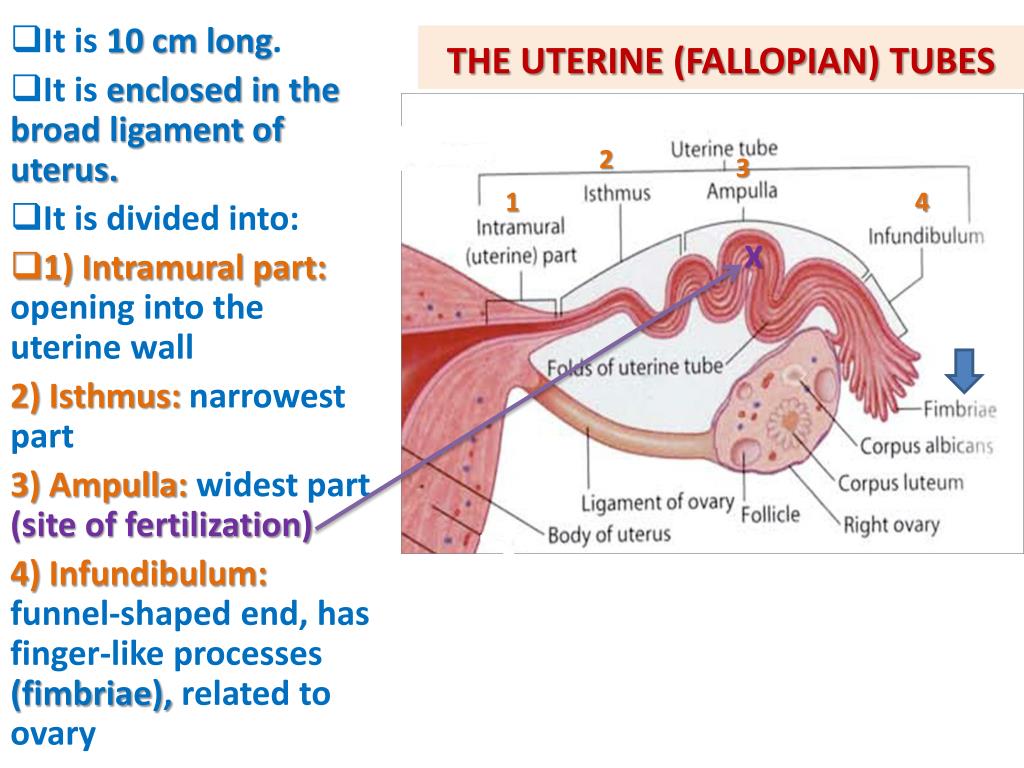
Polycystic ovarian syndrome (PCOS) is a condition that affects how a person’s ovaries function. The condition relates to hormonal imbalances in the body. Unlike endometritis, PCOS does not occur due to infection.
Experts do not know the exact cause of PCOS. However, the condition likely has a genetic link since it often runs in families.
In order to receive a diagnosis of PCOS, a person must experience two or more of the following:
- Irregular periods: This indicates that the ovaries are not regularly releasing eggs.
- Excess androgens: Androgens are male sex hormones. Both males and females have androgens, but some people with PCOS have higher levels than usual. Excess androgens can lead to physical changes, such as excessive facial or body hair.
- Polycystic ovaries: The ovaries can become enlarged, and ultrasound shows the presence of multiple small follicles or fluid-filled cysts in the ovaries.

PCOS is difficult to diagnose because its symptoms mirror those of other conditions, such as:
- cardiovascular disease
- acne
- depression
- sleep apnea
- type 2 diabetes
There is currently no cure for PCOS, though treatments are available to help alleviate the symptoms.
Endometritis can affect a person’s ability to get pregnant or stay pregnant. Inflammation of the uterus can cause scarring, which prevents an embryo from implanting and developing normally within the uterine wall.
A 2016 review reports that chronic endometritis can affect fertility by stopping the fertilized egg from implanting into the uterus lining and increasing the likelihood of repeated pregnancy loss.
However, the same study reports that antibiotic treatment can lead to a significant improvement in fertility and successful pregnancies.
A study from 2018 worked with 95 females who had fertility issues. They found that over half of the participants had chronic endometritis and that antibiotic therapy improved their symptoms by more than 80%. With successful treatment, they had increased pregnancy and childbirth rates.
With successful treatment, they had increased pregnancy and childbirth rates.
Fertility specialists sometimes suggest that people receive testing or treatment for endometritis, especially in cases of repeated pregnancy loss or multiple unsuccessful in vitro fertilization cycles involving embryos of good quality.
When diagnosing endometritis, a doctor will start by taking a medical history and performing a physical exam. The latter will likely involve a pelvic exam to evaluate the internal reproductive organs. The doctor will look for tenderness in the uterus and possible discharge from the cervix.
A doctor may carry out the following tests to rule out other possible causes of the symptoms:
- Blood testing: A complete blood count can help identify signs of infection or inflammation.
- Cervical cultures: The doctor may take a swab from the cervix to look for chlamydia, gonorrhea, or other bacteria.
- Wet mount: The doctor may collect discharge from the cervix and analyze it under a microscope.
 This can help to identify other causes of infection or inflammation.
This can help to identify other causes of infection or inflammation. - Endometrial biopsy: This procedure involves dilating the cervix to allow a small instrument or pipelle into the uterus. The instrument takes a small sample of tissue, and a doctor sends the sample off to the lab for analysis. It is a brief procedure that can take place in a doctor’s office.
- Laparoscopy or hysteroscopy: These procedures involve the use of a scope, which is a tiny camera attached to a thin, flexible tube. This allows a doctor to look directly inside the uterus.
A person should contact a doctor anytime they experience pelvic pain or discomfort or unusual discharge or bleeding. Some pelvic infections can cause serious complications, so it is important to start treatment quickly.
People who are at risk of developing endometritis should receive information from their doctor or nurse about the signs and symptoms to look out for. This includes people who have recently given birth and those who have recently undergone a pelvic examination or procedure.
A doctor may prescribe antibiotics to help prevent endometritis in situations where a person is at risk of developing the condition, such as when undergoing a scheduled pelvic procedure or surgery. A doctor may prescribe the antibiotics prior to or immediately following the procedure.
Because STIs can also cause endometritis, it is crucial that people maintain their sexual health, especially with nonmonogamous partners. Behaviors that can help include attending regular screenings for STIs and consistently using barrier contraception, such as condoms.
Without treatment, endometritis may cause the following complications:
- infertility
- pelvic peritonitis, which is a general pelvic infection
- abscess in the pelvis or uterus
- septicemia, which is bacteria in the bloodstream
- septic shock, which is severe and potentially life threatening low blood pressure due to septicemia
The outlook for a person with endometritis is very good, especially if they receive antibiotic treatment.
Getting a prompt diagnosis and appropriate treatment significantly reduces the risk of complications.
Inflammation of the uterus – causes and methods of treatment of diseases
Structure of the uterus
The uterus consists of three layers – the mucous membrane, the muscular layer and the peritoneum. The inflammatory process can occur both in one of these layers, and simultaneously in all three. Inflammation of the uterus often affects neighboring organs – fallopian tubes, ovaries.
Causes
Inflammation of the uterus can be caused by abortion, complicated childbirth, chronic inflammation of the vagina, ovaries, fallopian tubes, chronic venereal diseases.
Prices for an appointment with a gynecologist
Primary appointment with a gynecologist
Primary appointment – an appointment with a doctor of a particular specialty for the first time.
Make an appointment
1200 ₽
Repeated appointment with a gynecologist
The price is not valid for an appointment with a manager otd.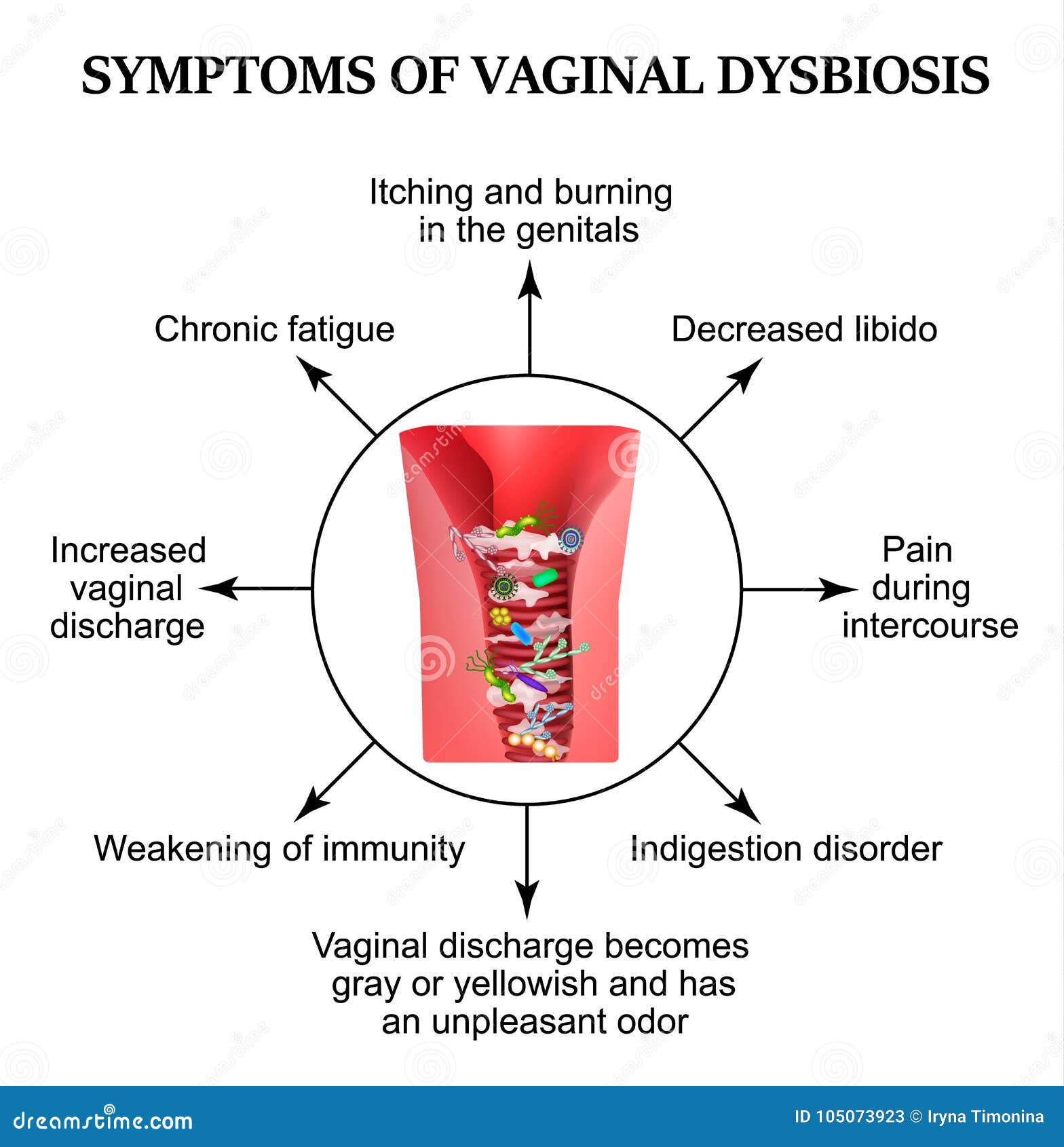 Jashiashvili M.D.
Jashiashvili M.D.
Make an appointment
1200 ₽
Ultrasound of the small pelvis in women (uterine cavity ovaries)
Make an appointment
1800 ₽
Endometritis
Endometritis is an inflammation of the lining of the uterus. Most often, this type of inflammation of the uterus occurs in women with complicated abortions and childbirth, if asepsis and antiseptics were used incorrectly during the intervention. This type of infection has recently occurred extremely rarely, which is associated with the legalization of abortion and the competent use of antiseptics.
Since the mucous cavity of the uterus is directly adjacent to the muscle layer, the inflammatory process from the endometrium very quickly passes to the muscles of the uterus. In such cases, metro-endometritis occurs.
Endometritis leads to discomfort and pain in the lower abdomen, lower back and sacrum, menstrual disorders, infertility and miscarriage. In advanced cases, this type of inflammation of the uterus can provoke oncological processes, so even if the presence of the disease does not cause any discomfort, it still requires mandatory treatment.
The inflammatory process from the mucous membrane of the uterus and the muscular layer can spread along the surface of the mucous membrane into the fallopian tubes (salpingitis) or through the lymphatic and vascular pathways into the periuterine tissue, the peritoneum of the uterus, and the venous plexuses of the small pelvis. In the latter case, microorganisms can penetrate into the general bloodstream and cause serious damage to a woman’s health.
Salpingitis, adnexitis, salpingo-oophoritis
Salpingitis (inflammation of the fallopian tubes) most often occurs when the infection enters the tubes from the uterine cavity. Less commonly, tubes can become infected in other ways. For example, through the blood, with influenza, scarlet fever, tuberculosis, dental caries, etc. Also, inflammation of the appendages can be caused by diseases of organs adjacent to the appendages of the uterus – the appendix, intestines, and bladder.
The inflammatory process in the pipes leads to deformation of the pipes and disruption of their patency.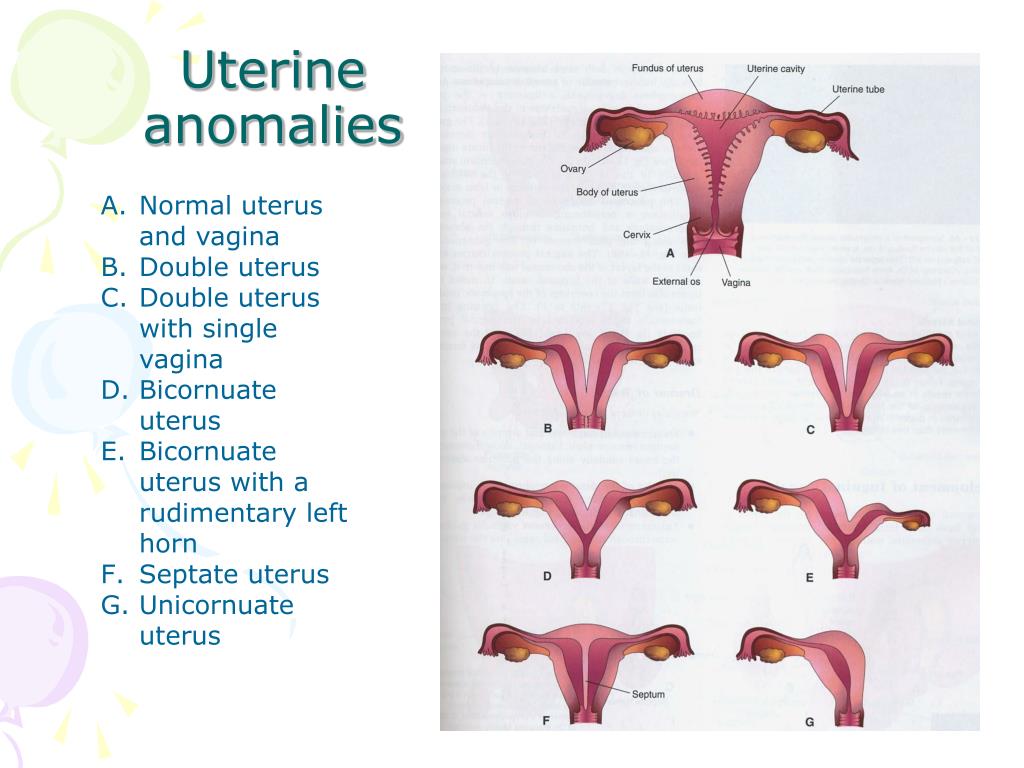 The inflammatory process in the tubes is often combined with inflammation of the ovaries. In these cases, they speak of inflammation of the uterine appendages (adnexitis).
The inflammatory process in the tubes is often combined with inflammation of the ovaries. In these cases, they speak of inflammation of the uterine appendages (adnexitis).
It is the obstruction of the fallopian tubes, to which inflammatory and infectious diseases have led, that most often causes female infertility.
After suffering an inflammatory process of the uterine appendages, serious functional disorders of the female genital area (uterine bleeding, infertility, etc.) are often observed. Long-term chronic inflammation of the uterine appendages is also unfavorable in oncological terms. We are talking about the possibility of malignancy as a result of prolonged irritation.
Most often, the process affects both the ovaries and appendages, in which case the disease is called salpingo-oophoritis.
Inflammation of the uterus (endometritis) – Obstetrics and gynecology – Departments of
Endometritis – inflammation mucous membrane uterus .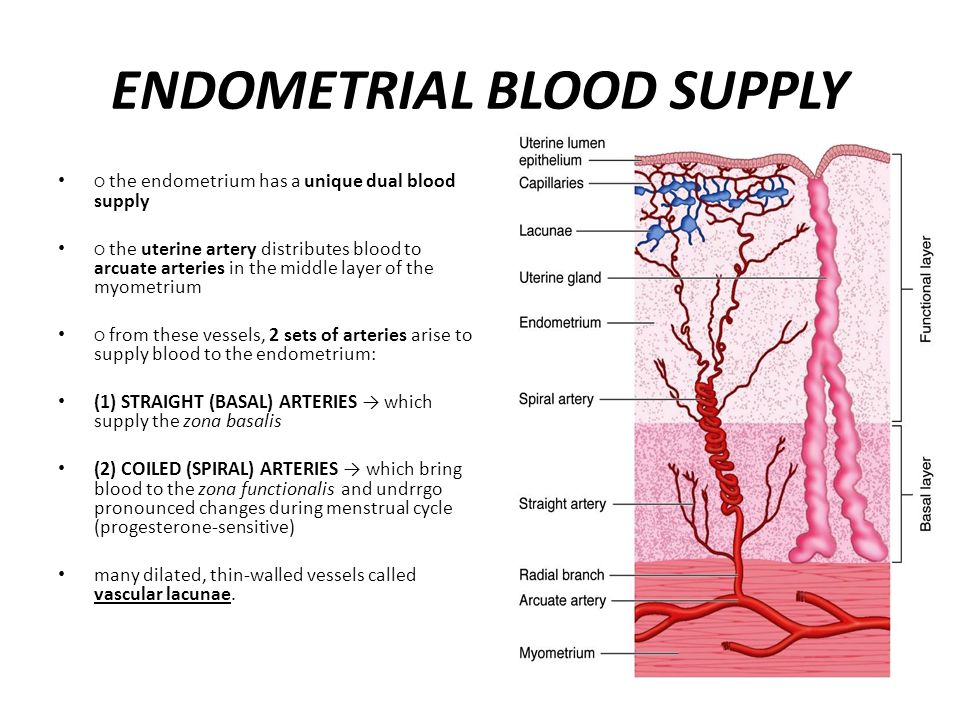 Acute inflammation of the uterus can be caused by a bacterial, viral or fungal infection.
Acute inflammation of the uterus can be caused by a bacterial, viral or fungal infection.
Endometritis according to etiology, tuberculous, gonorrheal, actinomycotic, and also nonspecific are distinguished. The causative agents of endometritis usually enter the uterus from the vagina through the cervical canal, or the infection spreads through the bloodstream. Infection and the development of inflammation of the uterus is possible in case of non-compliance with the rules of asepsis and antisepsis during intrauterine manipulations, therefore, most often endometritis develops after childbirth and abortion. Inflammation can spread to the muscular membrane of the uterus – myometritis (endomyometritis) develops.
Symptoms of endometritis usually develop 3-4 days after infection. Inflammation of the uterus can occur in acute or chronic form.
In case of acute inflammation of the uterus, the following are observed:
- general symptoms of acute endometritis : weakness, fever, blood test leukocytosis with neutrophilic shift to the left and increased ESR;
- local symptoms of acute endometritis: pain lower abdomen , liquid purulent discharge (sometimes sanious), enlarged and painful on palpation of the uterus of dense consistency.

Acute stage endometritis lasts up to 10 days and with adequate treatment complete recovery occurs. With improper or inadequate treatment, endometritis can become chronic.
Chronic endometritis is accompanied by pathological changes in the endometrium – its atrophy, hypertrophy or the formation of small cysts. The most pronounced a sign of chronic endometritis is a violation of the menstrual cycle with the development of bleeding. Chronic endometritis does not prevent conception, however, the implantation of the ovum into the altered endometrium is extremely difficult. Therefore, with chronic endometritis, there may be infertility and habitual miscarriage pregnancy . Also symptoms of chronic endometritis are serous-purulent discharge aching pain below belly . A bimanual gynecological examination shows a slight induration and enlargement of the uterus.
Diagnosis of chronic endometritis is based on history, symptoms, and histological examination of an endometrial scraping.
Women suffering from chronic endometritis who do not have pronounced symptoms often do not seek help from a gynecologist in a timely manner and develop complications of endometritis. Even after a single episode inflammation in the cavity of the uterus its traces remain – intrauterine adhesions. In this case, the endometrium loses its ability to function properly, which leads to termination of pregnancy at a short time or to infertility. Against the background of chronic endometritis, endometrial polyps can form.
Treatment of endometritis
In the acute stage of endometritis etiotropic treatment is necessary — antibacterial agents, taking into account the sensitivity of the pathogen to them inflammation of the uterus or broad-spectrum antibiotics.

 Without swift medical treatment, PID can become serious.
Without swift medical treatment, PID can become serious.
 This can help to identify other causes of infection or inflammation.
This can help to identify other causes of infection or inflammation.